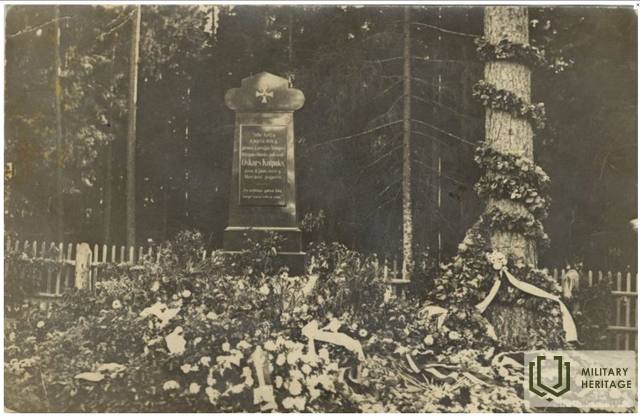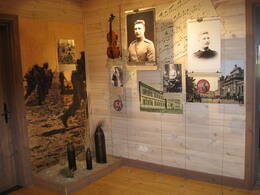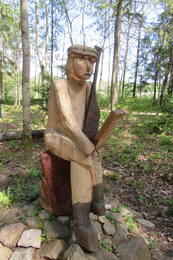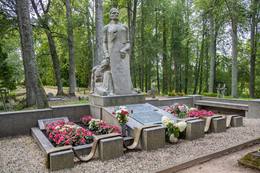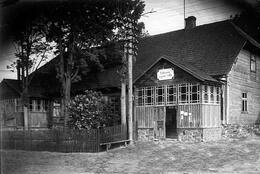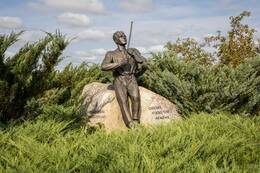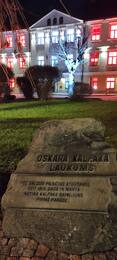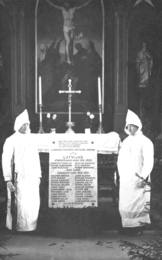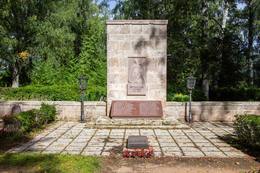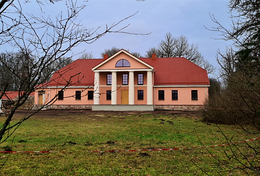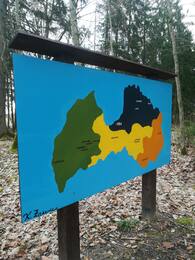Pulkininko Kalpako paskutinis mūšis netoli Airytės
Pulkininkas Kalpakas buvo gerbiama figūra kariniuose sluoksniuose ir tikras patriotas. Būtent patriotizmo dvasia ir nelaimingas atsitiktinumas lėmė lemtingą jo ir vokiečių batalionų susidūrimą, kuris, deja, baigėsi pulkininko Kalpako mirtimi.
Amžininkai Kalpaką apibūdino kaip mūšiuose užgrūdintą ir stiprų vyrą, lengvai susidorojantį su visais kareivio gyvenimo sunkumais, ir kartu paprastą bei nuoširdų, geros širdies žmogų. Generolas Ridigeris fon der Golcas, atvykęs į Kuršą iš Vokietijos, stebėjosi kasdieniu Kalpako paprastumu, tačiau kartu pripažino, kad pulkininkas jų susitikimų ir derybų metu žiūrėjo į jį gudriai. Golcas priešinosi Latvijos pajėgų skaičiaus didinimui, kurio Kalpakas natūraliai norėjo, nes vokiečiai turėjo savo viziją ir kitus planus Kuršui, o galbūt net visai Latvijai. Kita vertus, Kalpakas galvoje turėjo kovą už nacionalinę nepriklausomybę, ir nors derybos vyko supratimo dvasia, abiejų interesai buvo diametraliai priešingi.
1919 m. kovo 6 d. netoli Airytės įvyko tragiškas įvykis – atsitiktinis susišaudymas tarp Latvijos ir Vokietijos dalinių, tariamai dėl nesusipratimo, per kurį žuvo pulkininkas Kalpakas, kapitonas Nikolajus Grundmanis, pirmasis leitenantas Pēteris Krievs ir leitenantas Hansas Johannesas Schrindersas, kuris buvo priskirtas Kalpakams. Patyręs mūšio liudininkas pasakojo, kad miške kilo tikras pragariškas gaisras, sprogo patrankų sviediniai, sunkios minosvaidžio minos, skriejo kulkų spiečius... Todėl yra ir kitų šio atsitiktinio susišaudymo versijų – kad tai buvo tyčinė karinė operacija, kuria buvo siekiama susilpninti ar net sunaikinti Kalpakų pajėgas.
1922 m. Airītēse savanoriškai paaukotomis lėšomis buvo atidengtas Oskaro Kalpako paminklas, vėliau pastatyti muziejaus namai ir juose įrengta paroda apie Kalpako batalioną ir jo kovas. Muziejus atidarytas 1936 m. rugsėjo 6 d., tačiau po Antrojo pasaulinio karo likviduotas. Muziejus atnaujino savo veiklą 1990 m. lapkričio 11 d. ir dabar jį valdo Latvijos karo muziejus.
Šaltinis – knyga „100 istorijų apie Latviją“
Susijusios temos
Susijusios vietos
Oskaro Kalpako muziejus ir memorialinė vieta „Airītes“
Oskaro Kalpako muziejus ir memorialinė vieta „Airītes“ yra tarp Saldaus ir Skrundos, netoli greitkelio A9. Parodoje pateikiama išsami informacija apie pulkininką Oskarą Kalpaką ir jo batalioną, taip pat pristatoma Latvijos nacionalinės armijos ir memorialinės vietos „Airītes“ istorija. Parodoje pulkininką Oskarą Kalpaką pristatoma kaip asmenybę, kaip karį ir kaip kovotoją už Latvijos nepriklausomybę. Parodoje taip pat yra garso įrašų latvių, anglų ir vokiečių kalbomis. Juose pabrėžiama 1918/1919 m. istorinių įvykių svarba saugant Latvijos valstybingumą. Muziejaus pastatas yra restauruotas.
Įėjimas nemokamas; ekskursija su gidu – mokama. Komplekse yra poilsio zona, parkas, kliūčių ruožas, galima lankyti įvairius užsiėmimus, yra seminarų salė iki 30 žmonių.
Oskaro Kalpako muziejaus „Gamtos ir stiprybės takas“
Gamtos takas buvo sukurtas greta muziejaus esančioje teritorijoje ir yra paremtas 1936 m. O. Kalpako muziejaus ir jo aplinkos projekto idėja. Individualūs muziejaus lankytojai gamtos taku gali naudotis nemokamai.
Gamtos take eksponuojamos Kuldygos technologijų ir turizmo technikumo organizuoto medžio apdirbėjų plenero, kurio jungianti tema – „Už meilę laisvei“, metu sukurtos medinės skulptūros. Taip pat eksponuojami didelio formato paveikslai iš plenero „Saugok savo Tėvynę!“, kuriuos nutapė aplinkinių regionų moksleivių komandos.
Gamtos take taip pat įrengtas mini oro takelis jauniausiems muziejaus lankytojams.
Skrundos mūšio memorialas ir vėliavos diena
Skrundos mūšio memorialas yra Skrundos centre, Oskaro Kalpakos parke netoli Skrundos kultūros namų, Kuldygos ir Liepojos gatvių sankryžoje. 2005 m. prie memorialo buvo pastatytas akmuo, skirtas 1919 m. sausio 29 d. mūšiui atminti, kai Oskaro Kalpako vadovaujamas batalionas kartu su vokiečių ir rusų Landesvero daliniais išvadavo Skrundą nuo bolševikų. Vėliavos dienos tradicija tęsiama nuo 2004 m., minint pirmąjį iš bolševikų išlaisvintą miestą ir jo išvaduotojus, kurie 1919 m. sausio 29 d. Skrundos bažnyčioje iškėlė Latvijos vėliavą.
Pirmaisiais Nepriklausomybės karo mėnesiais Latvijos laikinoji vyriausybė, spaudžiama bolševikų, sparčiai prarado teritoriją. 1919 m. sausio 22 d. bolševikai užėmė Skrundą. Po savaitės, sausio 29 d., ankstyvą rytą, prasidėjo puolimas Skrundai atsiimti. Latvijos atskirasis batalionas, vadovaujamas pulkininko leitenanto Oskaro Kalpako, turėjo pulti Rudbāržu-Skrundos plentu ir išstumti bolševikus iš Skrundos. Po to turėjo vykti vokiečių dalinių flanginis puolimas, kurio užduotis buvo sunaikinti artėjantį priešą, o rusų kuopa turėjo pulti tarp Latvijos ir Vokietijos dalinių, orientyru naudodama Skrundos bažnyčią. Puolimą taip pat rėmė vokiečių artilerijos baterija. Puolimo dieną buvo 15 laipsnių šalčio, švietė ryški saulė, kalpakai turėjo kirsti giedrą lauką, o bolševikai slėpėsi dvaro akmeniniuose pastatuose. Bolševikai atidengė ugnį, kai užpuolikų grandinė buvo nutolusi apie 300 metrų, kilo abipusis susišaudymas, ir Oskaro Kalpako vadovaujami kareiviai sparčiai puolė į priekį, priversdami priešą nutraukti ugnį ir trauktis per Ventą. Po maždaug 3 valandų kovos Skrunda buvo užimta apie 9 val. ryto, Latvijos atskirajame batalione buvo sužeisti tik 2 kariai.
Skrundos mūšis turėjo didelę reikšmę Latvijos laikinosios vyriausybės ginkluotų Speko karių moralei, nes tai iš tikrųjų buvo pirmoji reikšminga pergalė mūšiuose prieš bolševikus. Be to, pats vadas Oskaras Kalpakas mūšyje demonstravo ypatingą drąsą, savo pavyzdžiu skatindamas karius nebijoti.
Pulkininko Oskaro Kalpako amžinojo poilsio vieta
Įsikūręs Visagalos kapinėse, Madonos apskrityje
Eksponuojamas Oskaro Kalpako paminklas, atidengtas 1927 m. liepos 10 d., Kārlio Zālės ir Arnoldio Dzirkalio – trijų figūrų kompozicija, kurios centre pavaizduotas senovės latvių karys su skydu ir kardu rankose, o abiejose jo pusėse stovi du kariai. Skulptūrinės grupės papėdėje ant granito pagrindo įstrižai pritvirtinta bronzinė lentelė, kurioje išgraviruotas tekstas, kuriame yra ir Edvardo Virzos eilėraštis, skirtas Kalpakui.
Oskaras Kalpakas žuvo 1919 m. kovo 6 d. netoli „Airītē“, Skrundos–Saldus kelio pakraštyje, o jo palaikai rugsėjo 18 d. iš Liepojos šiaurinių kapinių buvo perkelti į šeimos kapines Visagaloje.
Paminklą atidengė pulkininko O. Kalpako paminklo komiteto pirmininkas generolas J. Balodis, dalyvaujant tuometiniam Respublikos prezidentui G. Zemgalui, ministrui pirmininkui M. Skujeniekui, Saeimos pirmininkui P. Kalniniui, karo ministrui R. Bangerskiui ir K. Ulmaniui. Paminklo kertinis akmuo buvo padėtas 1925 m. birželio 19 d. Paminklo akmuo buvo paimtas iš pulkininko gimtųjų namų Sienos pelkėje, ant šio akmens O. Kalpakas vaikystėje mėgo groti smuiku.
Lubanos savivaldybės turizmo ir kultūros paveldo centras
Lubanos savivaldybės turizmo ir kultūros paveldo centras yra pačiame Lubanos miesto centre. Jame yra keletas ekspozicijų, įskaitant nuolatines, apie savivaldybės istoriją, kultūrą, tradicijas ir renginius. Nuolatinės ekspozicijos skirtos asmenybėms, kuriomis Lubana ypač didžiuojasi. Jose pristatoma poetė Broņislava Martuževa, Nacionalinio pasipriešinimo judėjimo narė ir politinė kalinė; politikas Hugo Celmiņš, Nepriklausomybės kovų dalyvis; Oskaras Kalpaksas, pirmasis Latvijos armijos vyriausiasis vadas; fotografas Alfredas Grāversas; operos dainininkas Jānis Zābersas; poetas Jānis Gavarsas; menininkas Rūdolfs Pinnis, taip pat folkloristas ir pastorius Mārtiņš Celmiņšas. Gidas pasakoja apie Lačplėšio karo ordino riterių ir laisvės kovotojų gyvenimą Lubanoje ir gretimoje teritorijoje, taip pat apie jų poilsio vietas senosiose Lubanos kapinėse. Galimos kalbos: latvių ir rusų. Ekskursijas su gidu su vertimu į vokiečių ir anglų kalbas galima užsisakyti iš anksto.
Pulkininko Oskaro Kalpako „Liepsalos“ gimtinė ir amžinojo poilsio vieta Visagalo kapinėse
Pulkininko Oskaro Kalpako šeimos memorialas Liepsaluose yra Maduonos ir Lubano ežero teritorijoje. Liepsalas yra Kalpako vaikystės namai. Memorialinė vieta čia buvo įkurta 1997 m., remiantis pulkininko dukterėčios Ārijos Kalpako-Grundmanės (1922–2006) idėjomis ir panaudojant jos išteklius. Vietovėje eksponuojami įvairūs aplinkos objektai ir akmens skulptūros, turinčios simbolinę reikšmę, perteikiančios Latvijos etines ir patriotines vertybes. Didžiausiame pastate įrengta ekspozicija, skirta Latvijos nepriklausomybės karo istorijai ir 22 Latvijos laisvės metams (1918–1940). Visagalo kapinėse esantis Oskaro Kalpako paminklas, kurį sukūrė Kārlis Zāle ir Arnolds Dzirkals, buvo atidengtas 1927 m. Paminklą sudaro trijų figūrų kompozicija, kurios centre – senovės latvių karys, laikantis skydą ir kardą, o iš abiejų pusių – po krintantį karį. Skulptūrinės grupės papėdėje ant granito pagrindo įstrižai pritvirtinta bronzinė lentelė su išgraviruotu tekstu, įskaitant Edvardo Virzos Kalpaksui skirtą eilėraštį. Oskaras Kalpaksas mirė 1919 m. kovo 6 d. netoli Airytės, prie kelio iš Skrundos į Saldų.
Memorial stone in Oskaras Kalpaka Square in Saldus
O. Kalpakos aikštė yra pačiame Saldaus centre, Lielā ir Striķu gatvių sankryžoje.
Buvusi turgaus aikštė šiandien yra mėgstama Saldaus gyventojų ir svečių poilsio vieta, kurioje rengiami koncertai, minėjimai ir šventės. 1919 m. kovo 10 d. Saldaus tapo pirmuoju Latvijos miestu, kurį išlaisvino pulkininko Oskaro Kalpako batalionas.
1919 m. kovo 14 d. aikštėje įvyko pirmasis Latvijos atskirojo bataliono paradas, o 1992 m., pulkininko Kalpako garbei, aikštė buvo pavadinta jo vardu.
Atminimo lentos Lubanos gyventojams, žuvusiems Pirmajame pasauliniame kare ir Nepriklausomybės kare, Lubanos liuteronų bažnyčioje
Įsikūręs Lubanoje, Baznīcas g. 1, liuteronų bažnyčioje.
Lubanos bažnyčioje galima pamatyti tarpukariu įrengtą balto marmuro atminimo lentą pulkininkui Oskarui Kalpakui. 1924 m. birželio 22 d. bažnyčioje buvo atidengta atminimo lenta žuvusiems Lubanos vidurinės mokyklos mokiniams. 1926 m. buvo atidengta Lubanos parapijos įrengta atminimo lenta žuvusiems parapijos gyventojams, taip pat atminimo lenta ministrui pirmininkui Hugo Celminiui, gimusiam Lubanos parapijos „Naglinoje“.
Medžiagos apie Oskaro Kalpako ir Hugo Celminio kasdienį gyvenimą galima pamatyti Lubanos kultūros ir istorijos paveldo bei turizmo informacijos centro parodoje.
Paminklas Smilteno gyventojų, žuvusių Nepriklausomybės kare, atminimui
Įsikūręs Smiltenės liuteronų kapinėse, Vaļnių gatvėje 11.
Paminklas Smilteno žmonėms, žuvusiems Nepriklausomybės kare, atminti buvo atidengtas ir pašventintas 1937 m. lapkričio 7 d. Paminklas pastatytas iš betono ir dengtas Allažių travertino plokštėmis. Paminklą suprojektavo architektas Verners Witands ir skulptorius Matīss Plukas.
Priešais paminklą 1937 m. spalio 31 d. iš šeimos kapo buvo perlaidoti 1919 m. kovo 6 d. Airītės mūšyje žuvusio Lačplėsio karo ordino kavalieriaus leitenanto Pēterio Krievo palaikai. 1937 m. lapkričio 7 d. prie jo kapo buvo pastatyta juodo granito atminimo lenta.
Kapinėse palaidoti keli Nepriklausomybės kare žuvę Latvijos šauliai ir Latvijos armijos kariai. Smiltenės evangelikų liuteronų bažnyčioje, abiejose altoriaus pusėse, 1927 m. spalio 2 d. dekanas Kārlis Kundziņš pašventino 2 balto marmuro atminimo lentas.
Lėtas dvaras
Dvaro pilis yra Lėnų kaime, prie Ventos upės. Šiuo metu pilis yra privati nuosavybė, todėl ją galima pamatyti tik iš tolo.
Dvaro rūmai nuo 1919 m. sausio pabaigos iki kovo 3 d. buvo naudojami kaip 1-ojo Latvijos atskirojo bataliono atramos punktas. Latvijos atskirasis batalionas turėjo išlaisvinti Leni dvaro apylinkes, kad galėtų kirsti upę priešais Jaunmuižą.
Dvaras priklausė baronui Friedrichui von Firksui, kuriam taip pat priklausė Rudbāržzi ir Sieksate dvarai. Dvaro rūmai buvo pastatyti XIX a. Baronui Lēnu pilis daugiausia tarnavo kaip medžioklės ir savaitgalio poilsio vieta.
Nuo 1927 iki 1937 m. pilyje veikė mokykla, o sovietų okupacijos metu – kolūkio medienos dirbtuvės. 1965 m. atidarytas bendruomenės centras. Pastatų ansamblis buvo daug kartų pertvarkytas, o parkas neišsaugotas. Išliko keli ūkiniai pastatai.
Oskaro Kalpakos muziejaus karinė-edukacinė užduočių trasa „Moksleivių kuopos kelias“
Užduočių trasa „Moksleivių kuopos kelias“ – tai atrakcija O. Kalpako muziejaus teritorijoje, kurioje komandomis reikia atlikti 7 skirtingo sudėtingumo užduotis (minimalus dalyvių skaičius komandoje – 3).




